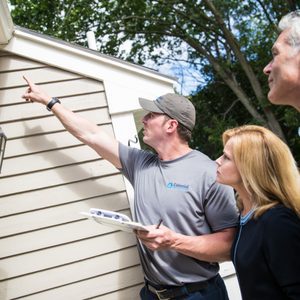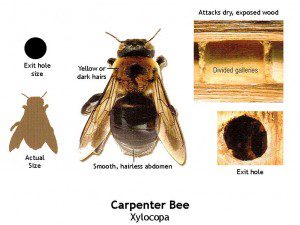Carpenter Bee Control & Carpenter Bees Extermination in Massachusetts & New Hampshire

Carpenter bees don’t get as much press as termites when it comes to damaging wood, but they shouldn’t be ignored. Carpenter bee control is crucial for maintaining the cosmetic and structural integrity of your home.
Like carpenter ants, carpenter bees don’t actually eat the wood; they chew into it to create a nest and galleries for development of their young. Carpenter bees are easily confused with bumble bees. Both are large, yellow and black, and noisy. While bumble bees have a fuzzy black abdomen, carpenter bees have a smooth, shiny black abdomen. Bumble bees nest in colonies; carpenter bees nest in pairs.
As bees go, the carpenter bee is pretty harmless. But you don’t get that impression from the behavior of the male bee. He’s the one who guards the nest opening and will buzz and bomb anyone who comes near. But he can’t sting; the female has a stinger but she is not aggressive and will sting only if provoked. She’s busy doing her job of chewing into your wood to create a nest. She chews a perfectly round opening and then excavates 6 to 8 brood cells, stocking each with a ball of pollen and a single egg. May is the prime month for nest construction in our area. Once the nest is complete, the adult pair moves on while the hatching larvae feed on the pollen balls inside their brood cells. When they have developed into adult bees in late summer, they emerge through the nest opening. These new adult bees often spend the winter in the nest and become active again and mate the following spring.
 Carpenter bees prefer to nest in softwoods such as redwood, cedar, and pine. Generally, they attack bare or weathered wood without paint or stain. Outdoor decks and unpainted edges of fascia board, soffits, cedar shingles, window sills, and roof trim are favorite nest sites. They will also nest in wooden deck furniture. A carpenter bee nest is fairly easy to identify. Carpenter bees in Massachusetts are the only wood destroying pests whose entrance hole is perfectly round and shirt button-size (1/2 inch diameter). Nests turn at a right angle beyond the opening and follow the grain for 4 to 6 inches, but galleries used by multiple bees can be much longer. Other signs of nests are sawdust-like frass beneath the nest opening, dirty yellow fecal stains on the siding or other surface outside the opening, and often the presence of the male bee patrolling the area.
Carpenter bees prefer to nest in softwoods such as redwood, cedar, and pine. Generally, they attack bare or weathered wood without paint or stain. Outdoor decks and unpainted edges of fascia board, soffits, cedar shingles, window sills, and roof trim are favorite nest sites. They will also nest in wooden deck furniture. A carpenter bee nest is fairly easy to identify. Carpenter bees in Massachusetts are the only wood destroying pests whose entrance hole is perfectly round and shirt button-size (1/2 inch diameter). Nests turn at a right angle beyond the opening and follow the grain for 4 to 6 inches, but galleries used by multiple bees can be much longer. Other signs of nests are sawdust-like frass beneath the nest opening, dirty yellow fecal stains on the siding or other surface outside the opening, and often the presence of the male bee patrolling the area.
It would be interesting to just observe the behavior of carpenter bees if not for the fact that they are digging into your wood, and once a desirable nest site is established, carpenter bees tend to return to that same site year after year. Carpenter bee damage is mostly cosmetic, not structural. However, damage can be serious when they nest in groups, or reinfest old nest sites, or if woodpeckers attack the wood trying to reach the carpenter bee larvae inside. The amount of damage that can occur is also proportional to the amount of suitable wood available for attack and the number of pairs nesting in the same site. When thin wood, such as siding, is attacked it can be completely penetrated, sometimes leading to rot and moisture problems in the structure.
Carpenter Bee Control
Carpenter bee control is one of our specialties at Colonial. Carpenter bee control – or “carpenter bees extermination” involves killing the developing bees in the nest and repelling adult bees from existing and potential nest sites. Our carpenter bee control service begins with a thorough inspection to find carpenter bee nests on and around your home. All accessible entrance holes and galleries are injected with either a dust or liquid formulation. We will also treat the roofline, fascia boards and any other affected areas. If necessary, we will access the attic and treat any active areas inside around the roofline. Our carpenter bee extermination service is guaranteed to protect your home and your wood from damage caused by carpenter bees.
Read more about carpenter bee control on our blog:
- Carpenter Bees Are Destroying Our Deck!
- Carpenter Bees. What’s the Buzz?
- Woodpeckers and Carpenter Bees
- What Caused Round Holes in Eaves?
Please call today for a FREE ESTIMATE for Carpenter Bee Control at 1-800-525-8084 or make the request online at – REQUEST A QUOTE